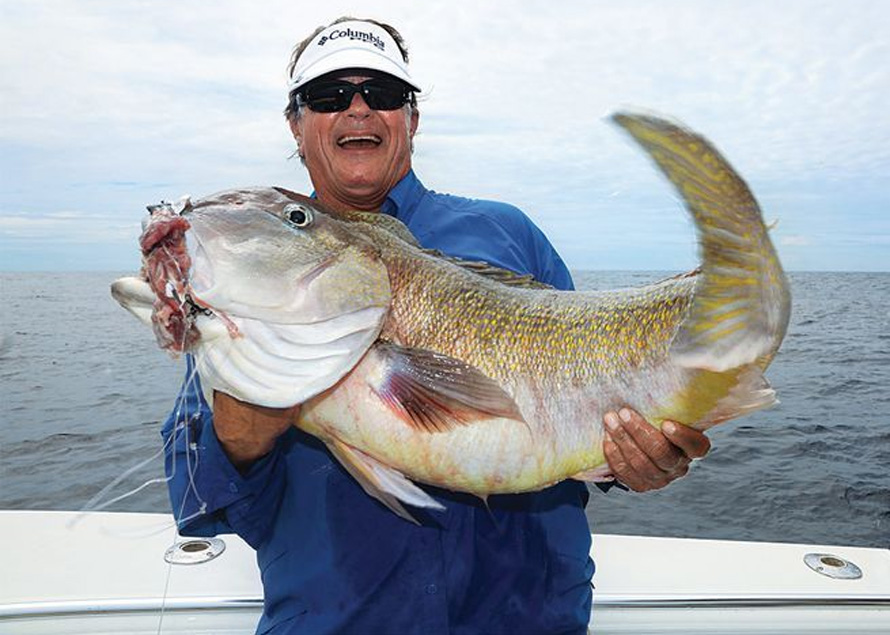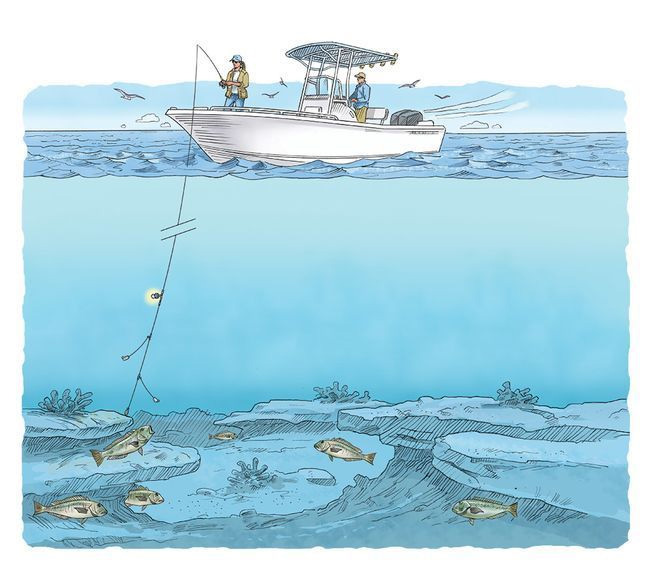Celebrating
|
Quick-change Deep Drop Rig For Tilefish
|
| Systematize terminal tackle for speed and efficiency with this rig |
| by George Poveromo |
 |
With the increasing popularity of hand-crank deep-dropping — versus pushing a button on an electric reel — refinements are evolving, e.g., the best reels, rods and lines for specific species and depths; the most potent terminal rigs; lights; the best baits; precision boat positioning; and more. It’s basically a new world down in these dark depths. Virginia Beach’s Beth Synowiec is one of these recreational, hand-crank deep drop aficionados, with a penchant for catching giant golden tilefish in depths from 700 to 1,000 feet. Her first ever drop for golden tilefish on December 31, 2010, aboard Captain Jake Hiles’ charter boat Matador and with Captain Mike Beane at the helm that day, resulted in a massive 41 pounder. Since then, she’s become obsessed with the species and techniques. In the last two years alone and aboard her own boat, ClassicRockfish, she has scored monster goldens as heavy as 36.10, 32.2, 28.5 and 28 pounds. And this past August, with the MARC VI in Virginia Beach, she put me on a monster golden tilefish weighing 33.4-pounds. I hand-cranked the behemoth up from 800 feet of water, along the fringes of the Norfolk Canyon! Simple and Easy I especially took interest in the configuration of her terminal rigs. As she explained, they’re quick-change, in that sections can be replaced within moments. She keeps duplicate components of the main leader, extension lines of various strengths, and swivels and lights in sealed, clear bags. “They’re boat-friendly,” says Synowiec. “I can easily fabricate these rigs on the ride out, make adjustments to an existing rig, or change out any parts a fish might have damaged. “I even have both golden and blueline tile rig components in different leader strengths, and swivel and hook sizes, should we wish to make a few drops for those on the way back in.” One thing her rigs aren’t is fancy. Deep-drop rigs can be tricked out to the hilt with chafe guards, glow beads, sound and vibration enhancers, and precision-crimped connections. However, in Synowiec’s case, speed and simplicity rule. Rig Basics For example, with the 130-pound mono she prefers for trophy goldens, there are no well-manicured, crimped connections. Instead she uses Dunkin or uni-knots. As is standard with most deep-drop rigs, an end loop at the bottom permits quick sinker changes. At the opposite end of the main leader is a 175-pound-test crane swivel attached to a 200-pound-test snap swivel on the fishing line. Synowiec also affixes a deep-drop light here.  |
| By building the terminal rig of various components, repairs are easy, saving the trouble of re-rigging should one part become damaged and need replacing. |
| 1.) Main Line 2.) 200-Pound Snap Swivel 3.) Attach Deep-Drop Line to Snap 4.) 175-Pound Crane Swivel 5.) 16 to 18 Inches, 130-Pound Mono 6.) 21 to 24 Inches, 130-Pound Mono 7.) 130-Pound Three-Way Swivel 8.) 16 to 18 Inches 9.) Snelled 7/0 Circle Hook 10.) 15 Inches 11.) Snelled 7/0 Circle Hook 12.) Sinker, Girth Hitched to Loop To minimize tangle risks when dropping to depths approaching 1,000 feet, the section of mono from the crane swivel to the first 130-pound, three-way swivel is 16 to 18 inches long. The section between this upper three-way swivel and the lower three-way swivel is 21 to 24 inches. And there’s approximately 15 inches between the lower swivel and sinker. Again, knots join these sections and swivels. The prominent use of swivels counters the line twist from dropping and retrieving, drifting and the current; the fishing line and terminal rig must lie perfectly straight as they soak on the bottom. No Loose Ends Some debate surrounds how long the extension lines or strands should be. However, to avoid tangling with the sinker, Synowiec’s lower strand is roughly 10 inches long. The length of the strand coming off the top three-way swivel is 15 to 18 inches. The dropper strands are tied to the swivels, whereas their 7/0 circle hooks are snelled. “The snell offers a more secure hook attachment,” she says. “It also keeps the hook somewhat straighter during the bait presentation.” For blueline tilefish in shallower waters, 80-pound mono is the foundation for her rigs (100-pound for really large bluelines). The strands are between 12 and 16 inches long from bottom to top, respectively, and 6/0 circle hooks get the nod. Straight Down A lot goes into deep-dropping for deepwater species, aside from locating the right type of bottom and delivering the bait. Synowiec mostly holds bottom with 24 to 28 ounces of weight, which, aided by some skillful boat handling to stem the current, allows her to stay put over promising bottom longer. Other than the upgrade to 32-ounce weights, our day was no exception. |
 |
| Tilefish hug the bottom, burrowing into the mud or existing structure. It’s essential to deliver the terminal gear with as straight a line as possible, through careful line handling and the cooperation of the person at the helm. The object is to maintain the straightest connection from the rod tip to the weight on the bottom. Make sure you continue to feel the weight dragging across the bottom once it’s been deployed over promising habitat. Illustration by Steve Sanford |
| Basic dropping rules: Lay the terminal gear straight in the water and then free-spool. Even with a heavy weight pulling the rig and line to the bottom, periodically pause to stop any bow from forming in the line and keep the delivery as straight as possible. Deep Strategy On bottom, Synowiec insists on staying in contact with the mud and feeling the weight drag across it. “These goldens live in deep burrows within this mud,” she reasons. “The rig must stay on the bottom long enough to slide across a colony of goldens and for the light and bait scent to interest them. Sometimes it feels like you’ve hung bottom when a big golden eats.” You need that heavy tackle to keep the fish from getting back into its burrow and hanging up. We were using stout Penn stand-up rods and two-speed Penn Torque 40NLD2 and Penn International 16 reels filled with 65- and 80-pound-test Sufix 832 braid. Once you get the fish, inspect the rig, change out anything that’s frayed or damaged, bait up again, and get back down there while you’re over a hot area. Though the quick-change rig outlined here is for large deep-dwellers the likes of golden tilefish, snowy grouper and barrelfish, it’s just as efficient when you scale down for smaller species like blueline tilefish, sea bass and fluke. |

